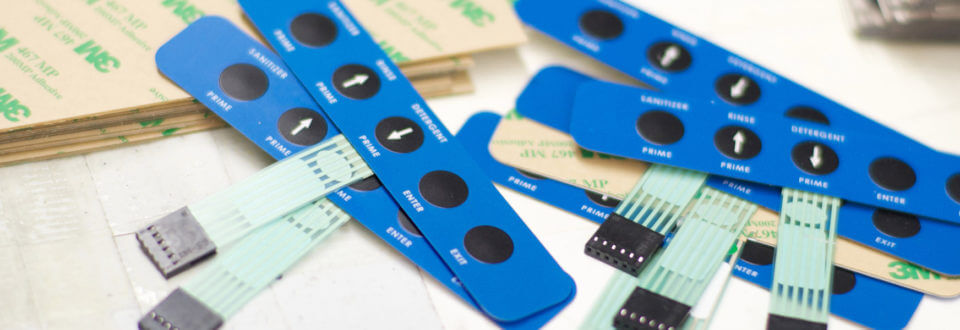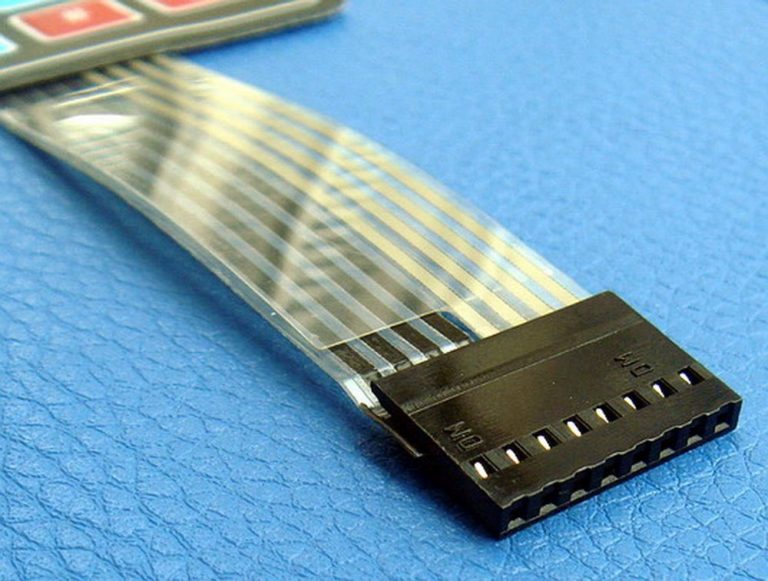Unlocking Advancement: The Benefits of Membrane Layer Switches in Modern Innovation
Membrane switches stand for a crucial advancement in customer interface modern technology, identified by their light-weight building and outstanding longevity. The style versatility intrinsic in membrane switches permits for personalized aesthetics and responsive responses, dramatically boosting individual interaction.
Introduction of Membrane Switches
Membrane switches are crucial elements in modern electronic tools, working as customer interfaces that help with communication in between machines and individuals. These buttons include several layers, generally consisting of a visuals overlay, spacer layer, and a printed circuit layer. Membrane Switches. The visuals overlay offers aesthetic directions, while the spacer layer divides the circuit layers till a switch is pushed, completing the circuit and registering customer input

Manufactured using sophisticated printing and layering strategies, membrane layer switches can additionally include one-of-a-kind appearances and shades, adding to visual charm. Their convenience expands to industries such as medical, automobile, and consumer electronic devices, where they play an important function in item functionality and design. As innovation developments, the relevance of membrane layer switches remains to grow, strengthening their position in the landscape of modern-day electronic interfaces.
Durability and Reliability
The longevity and integrity of membrane layer switches are fundamental characteristics that boost their charm in numerous applications. These switches are designed to hold up against harsh settings, making them optimal for usage in markets such as automobile, clinical, and commercial equipment. Normally constructed with durable materials, membrane switches stand up to moisture, dust, and chemical direct exposure, which makes certain constant performance even in difficult conditions.
Additionally, the lifecycle of membrane layer switches is substantially expanded due to their resistance to wear and tear. Unlike typical mechanical switches, which can weaken with time, membrane layer changes maintain their capability with extensive use. This durability is specifically essential in high-frequency applications where integrity is non-negotiable.
In addition, membrane buttons are less susceptible to failure from mechanical shock or resonance, giving a reputable interface for customers. Their capability to function properly across a variety of temperatures better contributes to their integrity in diverse environments. In general, the durability and integrity of membrane layer changes not just minimize upkeep expenses but also improve customer satisfaction, making them a superb choice for modern-day innovation applications.

Design Flexibility
An impressive element of modern-day membrane switches is their layout adaptability, which enables customization to fulfill certain customer demands and visual preferences. This flexibility is crucial in different markets, allowing producers to develop one-of-a-kind user interfaces that straighten with item branding and user interaction goals.
Membrane layer switches can be tailored in regards to form, dimension, and graphic style, helping with the assimilation of logos, color pattern, and useful aspects that resonate with the end user. This convenience is specifically beneficial in markets such as consumer electronics, clinical devices, and industrial equipment, where aesthetic appeal and functionality should coexist sympathetically.
Additionally, the use of advanced printing modern technologies enables complex styles and high-resolution graphics, boosting the total look of the interface. Various products can additionally be utilized to achieve differing responsive sensations, making certain that the button not just looks excellent but really feels right to the customer.
Enhanced Customer Experience
While interface have actually progressed considerably, look at here now the combination of membrane layer changes plays a critical role in boosting individual experience throughout different gadgets. These buttons offer a seamless interface that is both try these out intuitive and responsive, enabling users to interact easily with technology. Their tactile comments is made to supply encouraging verification without the mass of conventional mechanical buttons, contributing to a cleaner and more reliable format.
Moreover, membrane switches can be customized to fit specific customer requirements, guaranteeing that controls are easily obtainable and easy to understand. This adaptability is specifically valuable in developing user interfaces that deal with varied individual demographics, consisting of those with varying degrees of technology proficiency. Boosted durability and resistance to environmental aspects further expand the use of these buttons, making them a dependable option for both customer electronics and industrial applications.

In addition, the aesthetic allure of membrane buttons can significantly impact user perception, as they can be made in different colors, appearances, and graphics, thus enriching the general experience - Membrane Switches. By combining performance with layout, membrane layer switches over not just simplify customer interactions yet also raise the perceived worth of the device, eventually bring about greater user satisfaction and interaction
Applications Throughout Industries
Membrane layer switches have actually found extensive applications across various industries, demonstrating their versatility and efficiency in enhancing gadget functionality. In the healthcare market, these switches are made use of in clinical tools and analysis equipment, where reliability and convenience of cleansing are paramount. Their smooth style minimizes the build-up of dust and contaminants, making them excellent for sterilized settings.
In the customer electronics field, membrane switches are increasingly prominent in tools such as remote controls, devices, and video gaming consoles, thanks to their streamlined appearance and tactile feedback. The vehicle industry also uses membrane layer buttons in dashboards and control panels, where they add to user-friendly user interfaces and toughness versus harsh problems.
Additionally, the industrial sector gain from membrane buttons in machinery and control systems, where they supply durable operation and resistance to chemicals and dampness. Their compact and light-weight nature make them appropriate for mobile gadgets across different applications, including telecoms and customer items.
Final Thought
Finally, membrane switches over stand for a considerable improvement in contemporary innovation, supplying countless benefits including toughness, design adaptability, and enhanced individual experiences. Their capacity to supply and stand up to rough environments tailored interfaces makes them crucial throughout numerous markets. As technology remains to evolve, the assimilation of membrane layer buttons will play an important function in the development of cutting-edge tools, ultimately adding to enhanced functionality and individual satisfaction in contemporary digital applications.
Membrane layer buttons are important parts in modern digital tools, serving as customer interfaces that click over here promote interaction between makers and individuals. Membrane layer switches are lightweight and can be incorporated into small devices, using a space-efficient option compared to traditional mechanical switches.
Unlike typical mechanical switches, which can break down over time, membrane switches maintain their capability via comprehensive use.While individual interfaces have actually developed considerably, the assimilation of membrane layer switches over plays a critical function in improving user experience across different tools.In conclusion, membrane switches represent a substantial innovation in contemporary technology, using many advantages including longevity, layout adaptability, and boosted customer experiences.